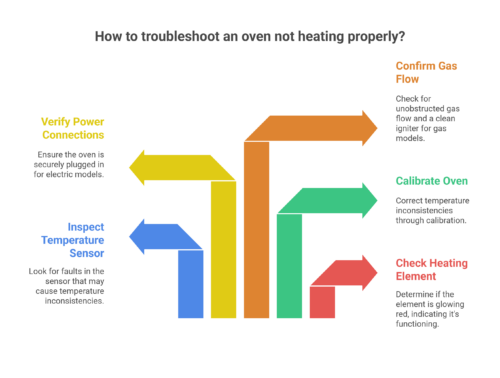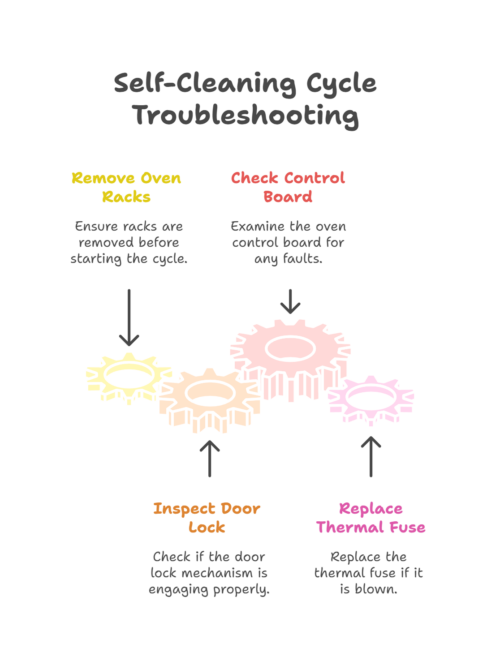Oven problems can quickly turn meal prep into a stressful experience, whether you rely on an electric oven or a gas oven. Understanding the most common oven issues is the first step toward regaining control in your kitchen. From temperature inconsistencies to doors that won’t close, these problems can disrupt your daily routine and even lead to higher repair costs if left unchecked.
By learning how to identify and troubleshoot common oven problems, you’ll be equipped to fix many issues yourself—saving both time and money. This guide will walk you through the most frequent challenges faced by owners of both electric and gas ovens, explain their likely causes, and provide practical repair solutions. We’ll also highlight the importance of regular maintenance to help you prevent future breakdowns. With the right knowledge, you can confidently tackle common oven issues and keep your appliance running smoothly.

Confirm that the gas flow is unobstructed and that the igniter is clean for smooth operation. Keeping these components in check ensures efficient functionality and consistent heat distribution.
If these steps do not resolve the issue, you may need to diagnose the problem further or consult a professional for assistance.
A burning smell can be alarming, but it might just be food debris on the heating element. Regular cleaning can help prevent this smell. If cleaning doesn't resolve it, check for electrical issues, as faulty wiring could also be responsible.
Identifying the source of a burning odor is crucial. Often, oils or grease dripped onto the element during baking can be the culprit. As noted in best maintenance practices, periodic cleaning of oven interiors is essential to avoid this nuisance.
An oven door that doesn’t close properly can lead to heat loss and uneven cooking. Check the following if your oven door won’t close:
Replacing worn-out gaskets or realigning the hinges can often fix the problem.
Checking the alignment of your oven door is paramount, especially since misalignment can reduce oven efficiency. To address such an issue, inspect and adjust door springs or the wiring to the door sensor.
Inconsistent temperatures may be caused by:
Addressing these parts may restore reliable oven operation, allowing you to cook your favorite dishes without surprise temperature drops.
Cooking in a dim oven is challenging.If your oven light doesn’t work:
Before resorting to professional fixes, ensure the bulb is properly screwed in and check the wiring connecting the socket. A damaged or faulty connecting wire could also be the reason the interior light is not working and may require professional attention. Taking time to examine these basic light features might save you an unnecessary service call.
Strange noises from your oven can be unsettling. Confirm if the fan is working correctly and not obstructed by debris. Cleaning the fan and its surroundings can often quiet down a noisy oven.
Often, abrasive sounds can originate from loose or malfunctioning parts within the oven’s internal mechanics. Keeping these pieces secure and in alignment can often solve noise problems. Loose or damaged screws can also cause noise, so check and tighten screws as needed. Don’t forget to inspect for broken fan blades or damaged belts as culprits of unexpected noises.

Additionally, a blown thermal fuse may disrupt the self-cleaning cycle and may require replacement. For specific troubleshooting steps and error codes related to the self-cleaning function, consult the owner's manual.
Acknowledging a non-working oven element is crucial for efficient cooking. Visually inspect the element for breaks or scorching. A replacement may be needed if the element is damaged.
For more technical insight, consider consulting the installation manual that often accompanies your appliance, which may offer specific troubleshooting guidance. Inspecting electrical connections to the element is another method to ensure the problem isn’t elsewhere in the circuit. If a replacement is not required, repairing the element or its wiring may be necessary to restore proper oven function.
A non-igniting gas burner can interrupt cooking plans. Check for clogs or buildup on the burner and ensure the igniter is clean and properly aligned. Cleaning or gently adjusting these components often resolves the issue.
To further solve issues, inspect the igniter’s glow when attempting to light the burner as mistaken settings or misaligned components, verified with a calibration tip, could impede performance.
If the burner still does not light, there may be something wrong with the wiring or settings that needs to be addressed.
When the timer on your oven stops working, your entire cooking routine can be thrown off balance. Confirm that the timer's settings are correct. If persistent problems occur, the timer might need replacing or resetting.
Occasionally, the digital interface may suffer from glitches; performing a soft reset could help remedy this without embarking on major repairs. Remember to consult your manual or a tech-savvy friend for aid if the issue seems beyond your capabilities.
Keeping your oven in top condition starts with regular maintenance. Simple habits can go a long way in preventing common oven issues and extending the life of your appliance. Here are some essential tips to help you avoid problems like a faulty igniter, malfunctioning heating elements, or a burned-out oven light:
By following these maintenance steps, you can help prevent the most common oven issues, reduce the risk of unexpected breakdowns, and keep your oven heating efficiently for years to come.
When oven problems interrupt your routine, you need quick, reliable repairs. At My Appliance Repair Pros, we offer:
📞 Call us today at (520) 788-4004 for professional oven repair and keep your kitchen running smoothly.
A well-maintained oven is the cornerstone of a reliable kitchen. By understanding common oven problems and taking proactive steps to maintain your appliance, you can avoid many of the frustrations that come with unexpected breakdowns. Regular cleaning, timely replacement of worn parts, and careful attention to your oven’s components will help ensure consistent performance and extend the life of your oven.
Remember, most repairs can be managed with a bit of troubleshooting and the right tools, but don’t hesitate to contact a professional repair service if you encounter complex issues. With these tips and a commitment to regular maintenance, you’ll keep your oven running smoothly, save on repair costs, and enjoy delicious home-cooked meals without interruption.
Here are the add-on sections for your “10 Common Oven Repair Problems and How to Fix Them” blog:
Why won’t my oven heat properly?
Common causes include faulty heating elements, a malfunctioning thermostat, or issues with the igniter in gas ovens.
Why do I smell burning when using my oven?
Often it’s food debris or grease on the heating element. Regular cleaning usually solves this, but electrical issues may also cause odors.
Why doesn’t my oven door close all the way?
Worn gaskets, bent hinges, or broken springs are common culprits.
Why is my oven making loud noises?
A noisy oven may have a loose fan, broken blades, or loose screws inside the unit.
When should I call a professional for oven repair?
If you’re dealing with electrical problems, faulty wiring, or repeated breakdowns, it’s safest to call a qualified technician.